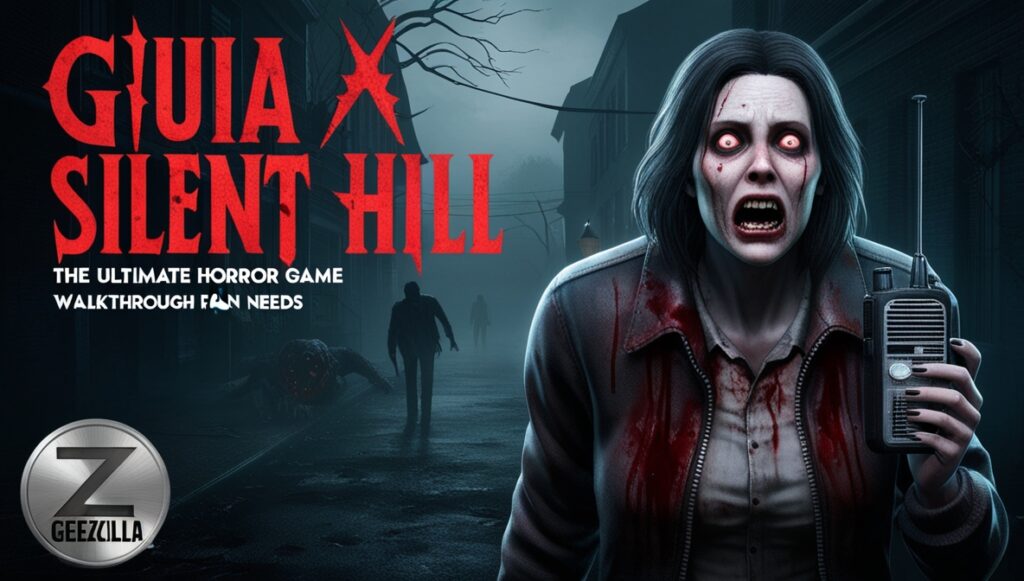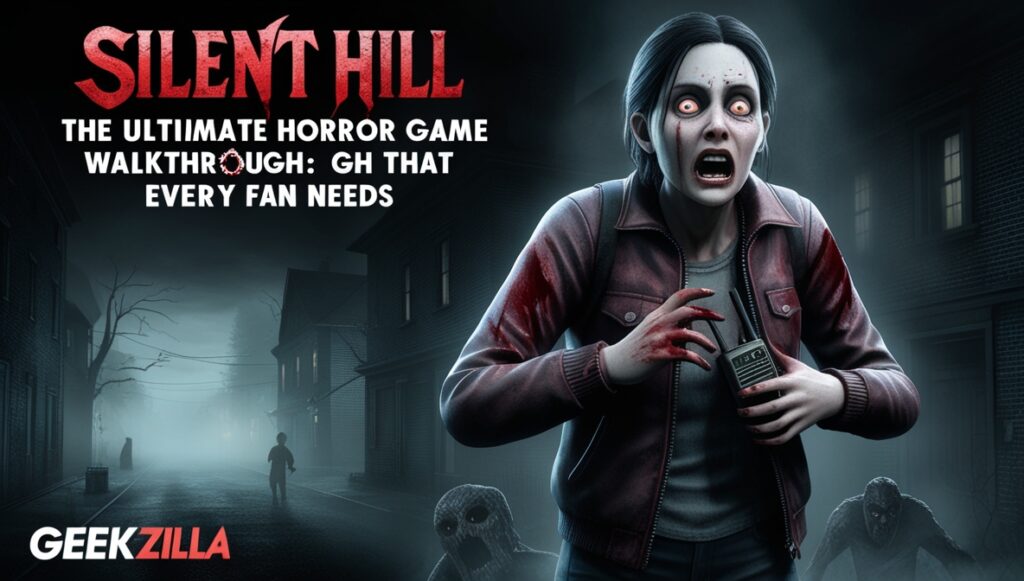The fog rolls in. Your heart pounds. Something lurks just beyond your vision, waiting to drag you into psychological terror. Welcome to Silent Hill, where nightmares become reality and every shadow holds unspeakable horrors.
Guia Silent Hill Geekzilla isn’t your typical walkthrough. This comprehensive guide transforms casual players into Silent Hill scholars, revealing layers of meaning most gamers never discover. Prepare to master every secret, decode every symbol, and conquer every nightmare.
Decoding the Guia Silent Hill Geekzilla Philosophy
The Geekzilla approach revolutionizes how we experience Konami’s masterpiece franchise. Unlike surface-level guides, this method dives deep into psychological profiling and trauma representation.

Guia Silent Hill Geekzilla treats each game as interactive psychological studies. Every monster tells a story. Every puzzle reflects inner torment. Every environment mirrors the protagonist’s fractured psyche.
This philosophy transforms gaming sessions into profound explorations of human darkness. Players don’t just survive; they understand why they’re suffering. The survival horror mechanics become tools for self-discovery rather than simple gameplay obstacles.
Key Geekzilla Principles:
- Symbolism analysis enhances terror experience
- Character psychology drives environmental storytelling
- Community discoveries unlock hidden meanings
- Multiple playthroughs reveal new interpretations
The Sacred Timeline: Geekzilla’s Definitive Play Order
Most guides recommend release order, but Guia Silent Hill Geekzilla demands better. The Geekzilla Silent Hill method prioritizes narrative impact over chronological gaming history.
Recommended Sequence:
- Silent Hill 3 – Establishes cult mythology and inherited trauma themes
- Silent Hill 1 – Origins story gains deeper meaning after understanding Alessa’s fate
- Silent Hill 4: The Room – Henry Townshend’s voyeurism complements earlier psychological themes
- Silent Hill 2 – James Sunderland’s journey becomes the emotional crescendo
This order maximizes psychological storytelling in games impact. Silent Hill 2’s devastating revelations hit harder when you understand the town’s true nature. Silent Hill 3 provides essential context for Alessa Gillespie’s tragic transformation.
Veterans can experiment with alternative paths, but newcomers should trust the Geekzilla gaming walkthroughs wisdom.
Psychological Architecture: Themes That Haunt Us
Silent Hill transcends typical horror through sophisticated symbolism in Silent Hill. Each game explores specific trauma manifestations while maintaining overarching thematic consistency.
Core Psychological Elements:
| Theme | Primary Game | Manifestation |
| Guilt | Silent Hill 2 | James Sunderland’s suppressed memories |
| Inherited Destiny | Silent Hill 3 | Heather Mason’s supernatural burden |
| Religious Fanaticism | Silent Hill 1 | Dahlia Gillespie’s cult manipulation |
| Voyeurism | Silent Hill 4 | Henry Townshend’s apartment prison |
Religious symbolism permeates every entry. The cult’s twisted Christianity reflects how denial corrupts spiritual beliefs. Parent-child relationships drive most character motivations, from Harry Mason’s desperate love to Dahlia Gillespie’s manipulative control.
The town itself becomes a psychological mirror, reflecting each visitor’s deepest fears. Shifting reality blurs the line between guilt and punishment, creating an atmosphere where anything becomes possible.
Character Dissection: Heroes, Villains, and Victims
James Sunderland – The Unreliable Narrator
James Sunderland represents Silent Hill 2’s masterful character psychology. His journey from concerned husband to revealed murderer showcases how denial shapes perception.
James’s psychological profiling reveals a man drowning in suppressed guilt. Mary’s illness became unbearable. His mercy killing transforms into selective amnesia. Silent Hill forces him to confront his true nature.
Heather Mason – Inherited Trauma Incarnate
Heather Mason embodies inherited destiny themes perfectly. Alessa Gillespie’s reincarnation carries supernatural baggage while maintaining teenage authenticity.
Her character arc explores how trauma passes between generations. The cult’s influence extends beyond death, making Heather both victim and unwilling participant in religious fanaticism.
Harry Mason – The Desperate Father
Harry Mason anchors Silent Hill 1 through paternal determination. His simple motivation – save Cheryl – contrasts beautifully with the complex mythology surrounding him.
His everyman perspective grounds the supernatural elements. Players identify with Harry’s confusion as Konami gradually reveals the town’s true nature.
Henry Townshend – Voyeuristic Prisoner
Silent Hill 4: The Room presents Henry Townshend as isolated observer. His apartment becomes both sanctuary and prison, reflecting modern urban alienation themes.
Henry’s voyeurism extends beyond peeping holes. He watches his neighbors’ lives while remaining disconnected from human intimacy.
Creature Feature: Monster Psychology and Symbolism
Monster design symbolism elevates Silent Hill beyond typical horror games. Each creature represents specific psychological concepts rather than random scary imagery.
Pyramid Head – Sexual Violence Embodiment
Pyramid Head symbolizes James Sunderland’s repressed sexual frustration and guilt. The executioner’s hood represents denial while his massive blade suggests violent masculine power.
His attacks on other monsters mirror James’s internal conflict between desire and self-punishment. Pyramid Head becomes James’s psychological executioner, delivering the justice he secretly craves.
Bubble Head Nurses – Corrupted Care Symbols
The Twin Victim nurses represent healthcare’s dark side. Their revealing outfits contrast with medical professionalism, reflecting how illness can corrupt intimate relationships.
These creatures embody James’s complex feelings about Mary’s deterioration. Care becomes burden. Compassion transforms into resentment. The nurses’ twitching movements suggest mechanical, emotionless assistance.
Abstract Daddy – Childhood Trauma Manifestation
Silent Hill 3 introduces Abstract Daddy, representing Alessa Gillespie’s sexual abuse trauma. The creature’s disturbing movements and sounds create visceral discomfort without explicit imagery.
This monster showcases Konami’s sophisticated approach to sensitive subjects. Horror emerges from implication rather than graphic content.
Master-Level Puzzle Solutions and Strategies
Silent Hill puzzle solutions test players’ analytical skills while advancing psychological themes. Guia Silent Hill Geekzilla reveals advanced techniques most guides overlook.
Shakespeare Anthology Puzzle (Silent Hill 3)
This complex riddle mode challenge requires literary knowledge and pattern recognition. The solution connects to Heather Mason’s intellectual development and inherited destiny themes.
Advanced Strategy:
- Study each play’s thematic connections to Heather’s journey
- Consider chronological order vs. thematic relevance
- Multiple solutions exist depending on difficulty setting
Hospital Lock Combinations
Silent Hill hospitals contain numerous locked areas requiring code combinations. Geekzilla gaming walkthroughs reveal pattern recognition techniques:
Combination Sources:
- Medical charts contain numeric clues
- Calendar dates reference significant story events
- Patient room numbers follow mathematical sequences
- X-ray films hide numeric codes when examined closely
Piano Puzzle Mastery
Silent Hill 1’s piano puzzle connects to Alessa Gillespie’s musical talents. The solution requires understanding her emotional state and musical preferences.
Expert Tips:
- Listen for discordant notes representing trauma
- Consider Alessa’s age when selecting melodies
- Multiple difficulty levels change required precision
Combat Mastery: Survival in Hell
Survival horror mechanics in Silent Hill prioritize atmosphere over action. Clumsy combat design intentionally makes players feel vulnerable and desperate.
Ammo Conservation Strategies
| Weapon Type | Best Use Cases | Conservation Tips |
| Handgun | Weak enemies, last resort | Aim for headshots, avoid moving targets |
| Shotgun | Multiple enemies, tight spaces | Save for unavoidable encounters |
| Melee Weapons | Single enemies, confined areas | Learn attack patterns, hit-and-run tactics |
Combat Decision Matrix
Inventory management becomes crucial for survival. Guia Silent Hill Geekzilla recommends this decision framework:
Fight When:
- Enemy blocks essential pathways
- Multiple escape routes are unavailable
- Carrying maximum healing items
Flee When:
- Alternative paths exist
- Low on ammunition or health
- Enemy appears purely atmospheric
Boss Battle Strategies
Each major enemy requires specific approaches rather than button-mashing:
Abstract Daddy: Circle-strafing while targeting weak points Pyramid Head: Survive rather than defeat; focus on evasion Leonard Wolf: Use environmental hazards and ranged attacks
Ending Completionist Guide
Hidden endings showcase Silent Hill’s sophisticated morality systems. Player choices throughout each game influence final outcomes subtly.
Silent Hill 2 Endings Analysis
| Ending | Trigger Conditions | Psychological Meaning |
| Leave Ending | Balanced health/Maria interaction | James accepts guilt, moves forward |
| In Water | Low health, frequent self-harm | James succumbs to suicidal depression |
| Maria | Excessive Maria focus | James replaces Mary with idealized version |
| Rebirth | Specific item collection | James attempts supernatural resurrection |
Silent Hill 2 Secret Endings
Dog Ending requires finding the “Dog Key” in New Game+ mode. This Shiba Inu joke ending provides comic relief while maintaining series traditions.
UFO Ending involves collecting specific items across multiple locations. The alien abduction scenario parodies conspiracy theories while referencing Konami humor.
Silent Hill 3 Ending Variables
Heather Mason’s fate depends on player aggression and exploration thoroughness:
Normal Ending: Standard completion with moderate violence Possession Ending: Excessive aggression triggers Alessa personality dominance
Silent Hill 4 Complex Endings
Silent Hill 4: The Room features the series’ most complex ending system:
Escape: Save Eileen, maintain apartment sanctity Mother: Allow Eileen’s Death, embrace supernatural influence
21 Sacraments: Complete Walter’s ritual requirements
Secrets, Easter Eggs, and Community Discoveries
Fan discoveries Silent Hill continue revealing new layers decades after release. Guia Silent Hill Geekzilla catalogs the most significant community findings.
The “There Was a Hole Here” Legacy
This iconic Silent Hill 4 message spawned countless internet memes. The simple phrase captures the series’ approach to environmental storytelling and voyeurism themes.
Hidden Developer Messages
Konami embedded numerous meta-commentary elements:
Silent Hill 2 Developer Room: Accessible through specific glitch exploitation Unused Monster Data: Datamined unused monsters reveal cut content and alternative design directions Hidden Textures: Wall textures contain developer signatures and inside jokes
Cross-Game Connections
Easter eggs link entries in subtle ways:
- Harry Mason references appear in later games
- Newspaper clippings connect different protagonists’ stories
- Radio broadcasts reference previous game events
- Konami references to other franchises (Metal Gear, Castlevania)
Silent Hill 2 Remake Integration (2024)
Bloober Team’s Silent Hill 2 Remake 2025 modernizes the classic while respecting its psychological complexity. Guia Silent Hill Geekzilla analysis reveals significant enhancements.
Updated Visual Symbolism
The remake’s improved graphics enhance monster symbolism without changing core meanings. Pyramid Head appears more menacing while maintaining his psychological significance.
New Environmental Details:
- Enhanced fog effects create deeper atmosphere
- Improved texture work reveals previously hidden symbols
- Updated lighting emphasizes psychological transitions
Modern Accessibility Features
Bloober Team added quality-of-life improvements without compromising difficulty:
- Optional combat assistance for accessibility
- Enhanced subtitle options for audio-based puzzles
- Colorblind-friendly visual indicators
Preserved Core Experience
Despite modernization, the remake maintains James Sunderland’s emotional journey. Psychological storytelling in games remains the primary focus over action sequences.
Advanced Fan Techniques and Speedrun Strategies
Horror game lore analysis extends beyond casual playthroughs. Advanced techniques reveal deeper appreciation for Konami’s craftsmanship.
Route Optimization Secrets
Speedrunners discovered sequence breaks that don’t compromise story integrity:
- Early Otherworld access through glitch exploitation
- Inventory management tricks for maximum efficiency
- Dialog skipping techniques that preserve narrative flow
Achievement Hunting Roadmaps
Complete achievement unlocking requires multiple specialized playthroughs:
First Playthrough: Story focus, moderate exploration Second Playthrough: Hidden endings preparation, item collection Third Playthrough: Speedrun achievements, combat challenges

New Game+ Strategic Advantages
Silent Hill games reward replay through enhanced understanding:
- Previously confusing story elements gain clarity
- Monster symbolism becomes more apparent
- Puzzle solutions reveal thematic connections
Mastering the Fog Forever
Guia Silent Hill Geekzilla transforms horror gaming from simple entertainment into profound psychological exploration. Silent Hill endures because it respects players’ intelligence while delivering genuine scares.
The franchise’s cultural impact extends far beyond gaming. Twin Peaks inspired horror games like Silent Hill influenced countless creative works across multiple media.
Your journey from casual player to Silent Hill scholar begins now. Master these techniques. Uncover hidden meanings. Embrace the fog that reveals truth through terror.
Silent Hill doesn’t just scare you—it changes you. Psychological horror games at their finest force confrontation with uncomfortable truths. Guia Silent Hill Geekzilla ensures you’re prepared for whatever nightmares await in that perpetually shrouded town.
The fog never truly lifts. Neither should your fascination with gaming’s most psychologically complex horror franchise.

